Have you ever wished to grow bare root strawberry plants but have no idea how to get started? If so, then you are in luck, because this article will introduce you to everything you need to know about growing these plants.
At the end, I will also give some tips on growing strawberries in grow bags.
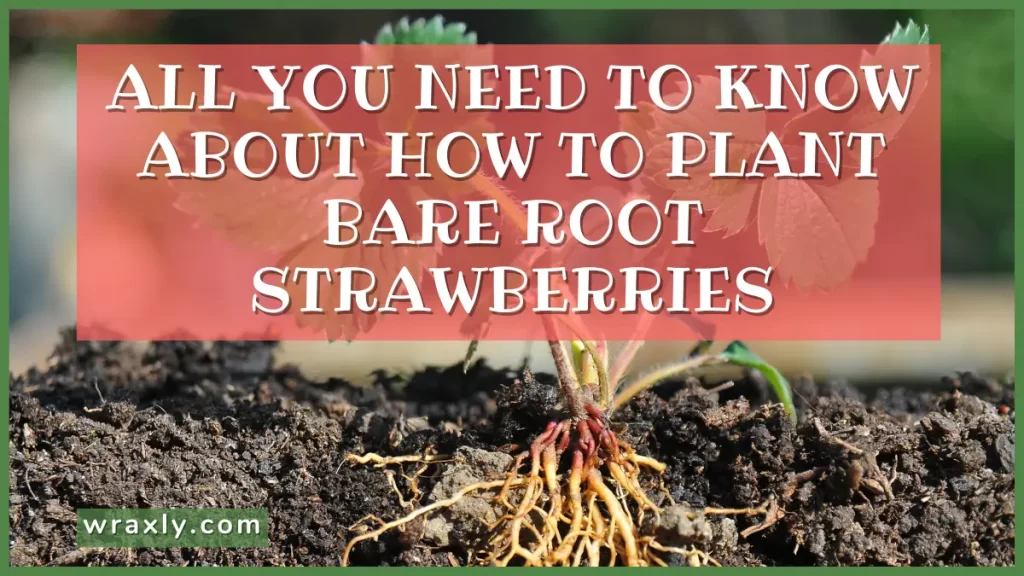
Prepare the Ideal Growing Conditions
Before you can grow a healthy plant, whether it be a strawberry with bare roots or not, you need to understand the importance of growing conditions. While there are many maintenance activities you can perform to aid your strawberry plants, those efforts will likely be futile if you don’t ensure proper growing conditions from the start. The next sections will show you what a strawberry plant needs when it comes to soil conditions and sunlight.
Soil Conditions for Bare Root Strawberry Plants
Bare root strawberries prefer soils that have a high concentration of organic materials for them to feed on. The soil should also have excellent drainage capabilities as a strawberry’s roots do not enjoy sitting in stagnant water. Typically, sandy loam soils are most capable of meeting those two requirements.
Soil acidity is also a crucial factor for bare root strawberry growth. Ideally, the pH of your soil should be between 5.8 and 6.2. Soils that are too acidic or too alkaline can both be detrimental to your strawberry plant’s development.
There is a good chance that the soil in your intended growing location does not match these conditions perfectly. But rather than leaving those conditions to chance, it’s better to begin by conducting a soil test. After receiving the results of that test, you should amend the soil until it has the proper acidity, drainage characteristics, and nutrient quantity for healthy strawberry growth.
Sunlight for Bare Root Strawberry Plants
While there is a lot to consider regarding the soil in which your bare root strawberry plants grow, understanding the sunlight needs of this plant is much more straightforward. Strawberry plants thrive in full sunlight. Ensure that your growing location receives at least six hours of direct sun exposure for the best results.
Choose One of the Three Bare Root Strawberry Varieties
What can come as a surprise to many novice gardeners growing bare root strawberries for the first time is that these plants can come in one of three varieties. Each variety of bare root strawberry has different bloom and fruit characteristics that will affect their harvest times. Here is a quick breakdown of those options:
- June-Bearing Strawberries – Produces a single large strawberry harvest in the months of June and July
- Ever-Bearing Strawberries – Produces two harvests during each growing season, one harvest arrives in early summer and the other arrives in early fall
- Day-Neutral Strawberries – Produces a light harvest continually throughout the growing season
The three types of strawberries listed above represent three distinct categories. Within those categories, you’ll find additional options, including cultivars with further variations in their fruiting schedules. However, it’s best to start by understanding the three main types so that you can have a clear idea of what to expect from your bare root strawberry plants.
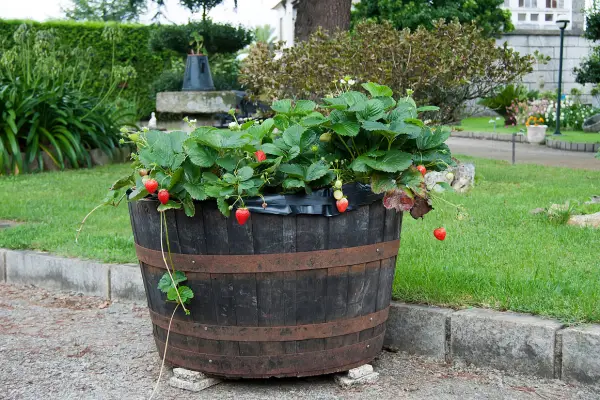
Soak the Roots in Water
After obtaining your bare root strawberry plant, but before you put it in the ground, you should take time to soak the roots. Soaking the roots will help the strawberry plant exit its dormant phase and prepares it to put forth new root and stem growth once it is living in the soil.
Typically, you should soak the bare roots of your strawberry plant for around five hours. When soaking these bare roots, you should not use water that has come directly from your tap. Tap water often contains harmful substances such as chlorine. Instead, you should use distilled water or tap water that has sat out for about a day, which allows the chlorine to dissipate from the water.
Root Prune Your Bare Root Strawberries
Now that you have selected a suitable growing location and soaked the roots of your strawberry plant, you are ready to move on to the root pruning phase. Many beginners may not be familiar with root pruning, but it is essential to the success of your strawberry plants.
Root pruning involves selectively cutting the roots of a plant to enhance their health and growth. You can perform root pruning on many types of plants and for different purposes.
When root pruning bare root strawberries, don’t be afraid to be a bit heavy handed. Observes the length of your strawberry plant’s root mass, then cut off about one third of that length.
Cutting your roots may seem like a harmful act. However, root pruning before your plant a bare root strawberry plant will encourage your plant to produce new root growth, which will help it absorb all the moisture and nutrients it needs from the surrounding soil.
Plant Your Bare Root Strawberries
At last, we have reached the step you have likely been waiting for. It is time to learn the ideal way to plant bare root strawberries. The next two sections will address both when and how to plant these plants the correct way.
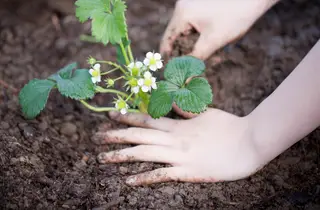
When to Plant Bare Root Strawberries
The best time to plant bare root strawberries is in the early spring months. Often, planting during March is ideal as this will give your bare root strawberries the chance to establish themselves and take advantage of the entire growing season.
How to Plant Bare Root Strawberries
To plant a bare root strawberry plant, you’ll want to pay close attention to the dimensions of your planting hole. Your planting hole should be deep enough that all the roots will grow under the soils surface. The part of the plant just above the roots, known as the crown, should sit at the soil’s surface, not above or below.
The width of your planting hole is critical as well. Again, you should observe the size of your bare root strawberry’s root system. Spread the roots out so that they are all free from one another and point outwards in a horizontal direction. Your hole should be wide enough to fit all of the spread-out roots without bending or overcrowding them, while providing additional open space in which the roots can spread.
When you have dug a hole that meets the requirements we just mentioned, place your bare root strawberry in the hole and backfill with nutrient-rich soil. You can also continue watering while you plant and backfill to keep the bare roots moist.
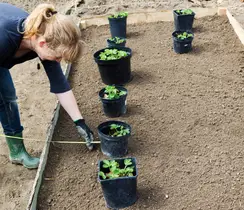
If you intend to plant multiple bare root strawberry plants in your strawberry bed, you’ll need to consider spacing as well. Strawberries love to expand when growing conditions are right, which is why you should provide at least a foot and a half to two feet between each strawberry plant you grow.
You may also be interested in… How to Grow Strawberries Indoors
Consider Using Containers for Your Bare Root Strawberry Plants
Planting your bare root strawberries in the ground is an entirely viable option. However, there are some advantages to growing your strawberry plants in containers instead.
As we just mentioned, strawberries tend to spread quickly when they find the growing conditions they prefer. Strawberry plants also prefer to have excellent drainage for their roots. Both of these traits make container gardening an excellent option for your plants.
Growing strawberries in a container will certainly help control the spread of your plants, as the container walls will serve as a distinct boundry for your strawberry plant’s roots. However, if you choose to use a container, you must ensure that the container you use allows water to drain freely.
Based on that need for drainage, fabric grow bags are one of the best options you can use when growing strawberries. The permeable nature of these bags allows them to release excess water with ease and helps maintain fantastic air circulation around the root system.
Recommended Containers for Growing Strawberries
| Image | Title | Prime | Buy |
|---|---|---|---|
 | Strawberry Grow Bags 3 Gallon, Luxiv Strawberry Planting Bags with 12 Grow Pouches Plant Growing Hanger Bag for Tomato, Chili, Strawberry Planting Containers Garden Grow Bags (3, Green+Black) | PrimeEligible | Check Price on Amazon |
Top | Mr. Stacky 5-Tier Strawberry Planter Pot, 5 Pots | PrimeEligible | Check Price on Amazon |
 | Grow Bags,Strawberry Planter Bags with Flap and Handles,3 Pack 10 Gallon Heavy Duty Fabric Plant Pots for Tomato,Carrot, Onion, Fruits, Flower and Vegetables | PrimeEligible | Check Price on Amazon |
 | Cedilis 4 Pack 10 Gallon Strawberry Grow Bag with 9 Side Planting Pockets, Breathable Fabric Strawberry Planter Pot with Handles for Growing Strawberry, Black | PrimeEligible | Check Price on Amazon |
 | Hanging Strawberry Grow Bags Planter-3 Gallons Gardens Upside Down Planter with 12 Grow Pouches Plant Growing Hanger Bag for Tomato, Chili Planting Containers Garden Grow Bags (Red + Green) | PrimeEligible | Check Price on Amazon |
 | Reeyox Strawberry Grow Bag, 2 Pack 10 Gallon Strawberry Plant Bag with 8 Side Planting Pockets, Breathable Felt Material Plant Container with Handles for Balcony Courtyard Gardening (Black) | PrimeEligible | Check Price on Amazon |
 | Hanging Strawberry Planter Outdoor Upside Down Tomato Planter Indoor Strawberry Hanging Grow Kit Tomatoes Vertical Design Hanging Tomato Planters Tomato Plant Hanger with Holes Hook Included | PrimeEligible | Check Price on Amazon |
Cover the Soil with Mulch
After you plant your strawberry plants in the ground, you should cover the area with mulch. Mulch will help maintain the correct soil moisture that your new plants need to thrive. It will also help moderate soil temperatures and breakdown into more organic nutrients over the long run.
Mulch is more important for a strawberry plant than you might first expect. Strawberries tend to have shallow roots and a high need for water. The moisture retaining capabilities of mulch will go a long way towards helping you save some water.
Mulch will also help prevent weeds from popping up, which can compete with your strawberries for nutrients. When you apply mulch, you should be sure not to cover the crown of your plant, but otherwise you should lay a healthy mulch layer that is at least an inch thick.
You may also be interested in How Many Strawberries per Plant
Water Your Strawberry Plant
Once your bare root strawberry plants are in the ground, you’ll need to continue supplying plenty of water to keep their soil moist and help them adapt to their new growing location. In most cases, you should water your newly planted bare root strawberries once per day. Each time you do, you should give about one to two inches of water.
Keeping up with this watering schedule can be difficult for some, which is why you may want to seek a watering method other than watering by hand. Drip irrigation systems are often the best way to give your strawberries the water they need in an efficient way. See also: Growing Hydroponic Strawberries
Final Thoughts
As you can now see, planting bare root strawberry plants is not all that difficult to do. As long as you follow the simple steps we’ve laid out in the article above, you should face minimal challenges and soon your strawberry plants will be well on their way to producing a harvest for you to enjoy.
Can I grow strawberries in a grow bag?
Planting your strawberries in grow bags is likely to provide the best chances of success. All you need to do is give them fertile, rich soil and a sunny placement.
What size grow bag for strawberries?
For your strawberries, you can choose between the five and eight-gallon sizes. Either of these will give each of your strawberry plants sufficient space to grow and more soil nutrients per plant.
Read more about growing strawberries in grow bags.

John Haryasz is a freelance writer and landscape designer. In the field of landscape architecture, he has contributed to many successful design projects throughout the country. As a writer, John specializes in creating captivating and informative web content. Through that work, he aims to share his design knowledge and promote engagement with the outdoor world.

![How to Water Indoor Plants [Plant Care 101]](https://wraxly.com/wp-content/uploads/2021/03/How-to-Water-Indoor-Plants-Plant-Care-101-1200-1024x576.webp)
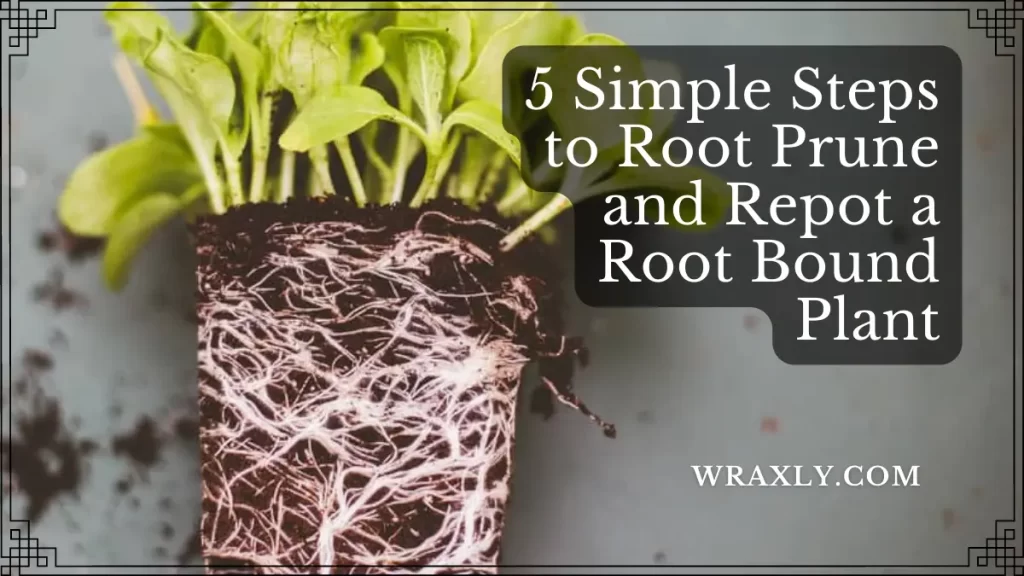
![Growing Plants from Cuttings [A Simple Guide]](https://wraxly.com/wp-content/uploads/2021/03/Growing-Plants-from-Cuttings-A-Simple-Guide-1200-1024x576.webp)